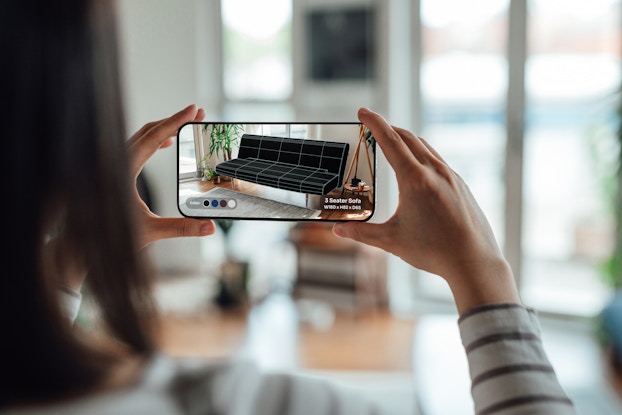
Over the last couple of years, the global virtual reality and mixed reality markets, including augmented reality (AR), have skyrocketed and are expected to reach over $250 billion in the United States by 2028. With the accelerated emphasis on embracing new technologies, companies have started incorporating AR technology into their marketing and customer relations strategies to ensure their user experience is truly unique.
Here are five ways small businesses can leverage augmented reality in the contexts of marketing or customer experience and loyalty.
Videos
One of the most recognizable applications of augmented reality as a marketing strategy is video filters on photos and videos. Social media platforms, like Snapchat and TikTok, made the feature incredibly popular among platform users. Over 250 million Snapchat users access the AR filters daily, and since its launch, Snapchat creators have built and shared over 2.5 million augmented reality lenses.


Other brands have applied this same technology of superimposing a graphic animation over an image or video to their experiential marketing efforts. In a 2014 campaign, Pepsi installed AR-enhanced bus shelters to make it seem as though unexpected objects, like UFOs and a lion, were coming toward waiting passengers. Rather than showcasing their product, this approach created a unique brand moment that gave consumers a surreal experience they eagerly shared, generating word-of-mouth buzz for Pepsi.
[Read more: Augmented and Virtual Reality Will Play Big Roles in Small Business Post-Pandemic Plans]
Interactive packaging
Online shopping has allowed companies to use shipping packages and materials to promote their brand. Some brands have taken that strategy one step further by incorporating QR codes that launch an augmented reality application to enhance the customer’s product experience.
These applications range from the practical — providing additional information about the product, such as nutritional values, recipes to try, interactive food demonstrations to follow, product composition, or pharmaceutical details on the medication along with possible side effects and drug interactions — to entertaining, including interactive smartphone games and exclusive giveaways.
One of the most recognizable applications of augmented reality as a marketing strategy is video filters on photos and videos.
Customer service
Because of its immersive and interactive abilities, augmented reality can help brands enhance and improve their customer service experience. For example, brands can use AR to demonstrate how to use a product’s more complex features, as Hyundai and Toyota have for their new car models.
Some companies have incorporated augmented reality to provide in-store customer service. Lowe’s is one such company; they developed an in-store navigation app that uses graphic overlays to give customers visual directions to their desired aisle and product. With AR, Lowe’s has taken its in-store app experience one step further to notify customers of current sales, promotions, and other products they might be interested in while shopping in their physical store locations.
Try-before-you-buy options
Online shopping revolutionized the consumer experience, allowing customers to explore and purchase goods worldwide. While most customers have fully embraced shopping online, there are some in-store shopping experiences that online shopping can’t replace or replicate.
However, with the advent of augmented reality, fashion and beauty brands can now offer try-before-you-buy options to customers. For example, the Sephora Virtual Artist App allows customers to try on whichever cosmetics they like. With smartphone cameras, the app maps the customer’s facial features to overlay their selected beauty products onto their faces. Customers can experiment with different color shades and brands before committing to purchase.
Some apparel brands have also incorporated AR to enhance the try-on experience for their customers. Memory Mirrors by Neiman Marcus and Dressing Room by Gap help customers understand how the clothing will fit with 360-degree views and AR-generated models that match customers’ body shapes and sizes.
[Read more: Augmented Reality: A Realistic ‘Try-Before-You-Buy’ Visual Experience Drives the Evolution of Brands Like Wayfair]
Immersive shopping experiences
When customers do venture into brick-and-mortar locations, brands are using AR to enhance their customers’ in-store experience. For example, the Starbucks flagship in Shanghai implemented an augmented reality experience where customers can use their smartphones to unlock exclusive visuals and learn more about their products and roasting process.
Alibaba, the company behind this in-store AR integration, used the same principle to create and launch 1,000 virtual 3D Yihaodian grocery stores across China. Only customers who download and use the Yihaodian app can shop in these virtual grocery stores near one of their physical store locations.
CO— aims to bring you inspiration from leading respected experts. However, before making any business decision, you should consult a professional who can advise you based on your individual situation.
CO—is committed to helping you start, run and grow your small business. Learn more about the benefits of small business membership in the U.S. Chamber of Commerce, here.







